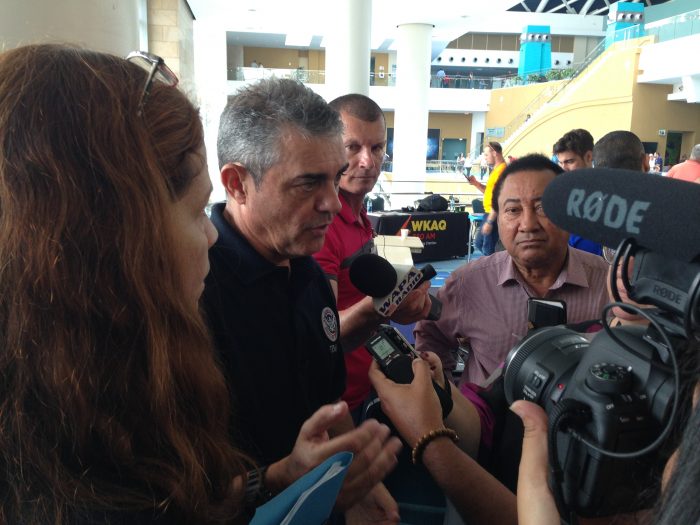SAN JUAN, PUERTO RICO — Some hospitals in Puerto Rico could shut down, leaving hundreds if not thousands of lives at risk due to the high demand for diesel a week after Hurricane María devastated the island.
Although there were gasoline reserves for 15 days, according to the Puerto Rican government, diesel has had higher demand than gas. Hospitals, restaurants, office buildings and even some residential homes all run on diesel power generators. The government says only four hospitals have been energized by the Puerto Rico Energy Power Authority (AEE or PREPA). Those hospitals are the Medical Centers in Río Piedras and Mayagüez, the HIMA San Pablo in Bayamón and an unspecified hospital in downtown Mayagüez.
But those four hospitals are not enough to provide adequate medical services to the 3.5 million American citizens living Puerto Rico.
In an interview on WKAQ Univision Radio, Dr. Sarah López, director of the Caribbean Medical Center in Fajardo and Secretary of the Hospital Association of Puerto Rico, urged the government to do more to help keep the hospitals supplied. Caribbean Medical Center was one of the few hospitals in the eastern region of Puerto Rico to maintain operations during Hurricane María, even conducting operations and emergency birth procedures from patients from as far away as Humacao. López also thanked Puerto Rico’s Speaker of the House Carlos “Johnny” Méndez for securing diesel fuel for the hospital and for pledging to make sure the hospital is supplied.
Amid power outages, hospitals pushed to their limits in Puerto Rico https://t.co/WS77mFis8S pic.twitter.com/lPDsf5leV8
— Los Angeles Times (@latimes) September 27, 2017
Other hospitals desperate for diesel are the Menonita Health Group, who operate four main hospitals in Caguas, Cayey, Aibonito, and Cidra—all towns heavily damaged by María.
Latino Rebels reached out to Peter Quiñonez, Press Secretary of the Puerto Rico Department of Health (PRDH), for information on the number of hospitals that the government has been supplying with diesel, but as of this publication, the information has not been received.
Not Just Hospitals
Many municipalities are also unable to collect trash, which has been piling up in the streets outside homes throughout the island. The problem? Most trash collecting trucks are in need of diesel to operate and collect the waste. Long-term health risks include but are not limited to rats and other disease carriers spreading their viruses throughout the island.
The morning struggle in San Juan. Lines for foodstuffs, cash and fuel, and garbage/debris that hasn’t been picked up since the hurricane. pic.twitter.com/IT4pzPlrRp
— Armando Valdés (@armandovaldes) September 27, 2017
The San Juan Municipality did contract outside companies to pick up trash in some areas, but the city itself is still not trash free.
Alejandro De La Campa, FEMA Director for Puerto Rico, described the entire situation on the island as catastrophic.
“We’re talking about a category five. We’re talking about that the main difference between Katrina and Sandy [in regards to María] is that trucks can’t come through roads from neighboring states with supplies,”De La Campa said in impromptu press meeting at the Puerto Rico Convention Center where the Joint Emergency Operations Command is located. “Everything must be brought over by airplanes and ships. the majority being military. We have the resources to respond, but we must place it in perspective that this is the most catastrophic event that Puerto Rico has suffered in recent years.”
De La Campa admitted that the first days after María, the push to supply hospitals with diesel was based on a “call if you need” basis. But FEMA, in conjunction with the local state government, has begun a plan to supply all active and working hospitals while PREPA tries to restore power.
“We are working in conjunction with the PRDH and the Department of Health and Humans Services (DHHS), to work out the applications as they come in, we are sending the fuel. In fact, right now we have a plan of action where day to day, for the next few days, we send to specific hospitals in the plan” De La Campa said.
“In terms of diesel, I want to make clear, and I have said this in various media outlets, FEMA does not control the fuel supply in Puerto Rico. We have hired a series of corporations that supply us. We do not understand why those corporations do not supply supermarkets and other businesses that are soliciting the service. But no one can say that FEMA is controlling the fuel because it’s not true,” De La Campa added.
The U.S. Navy, in conjunction with FEMA, has the USS Kearsage stationed in San Juan, providing humanitarian and medical assistance since late last week. Also the Navy announced in a Washington Post article that the USS Comfort would be sailing from Norfolk, Virgina, to San Juan to help out with medical needs.
The government was not ready for the collapse of the entire electrical power grid and the supply problems worsened due to the lack of communications outside of the metropolitan area. The sooner PREPA can reestablish energy to hospitals and other important areas, the less diesel will be needed, and the demand can be routed to other needs that will help Puerto Rico restart its economy faster.
***
Edwin Jusino tweets from @erjusinoa.



